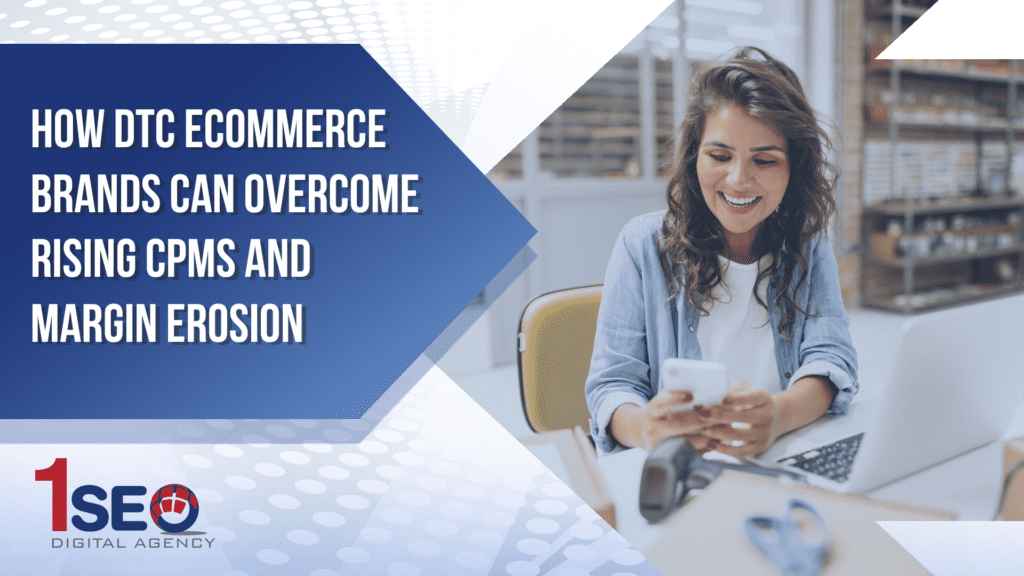Speak To An Expert Now: 215-946-1046

Drive More HVAC Traffic With Search Intent
As search engines like Google continuously update to make sure users are getting the correct information and best possible experience each time they punch a

The landscape of DTC ecommerce is rapidly evolving. As brands that sell directly to consumers face escalating costs in digital advertising—especially through cost-per-thousand impressions (CPM)—and increased margin erosion, it’s more critical than ever to adopt strategic, data-driven approaches. The shift from traditional retail models to digital-first DTC commerce has opened immense opportunities, but it also presents formidable challenges that require precision in marketing, technology, and customer engagement.
In this article, we’ll explore the foundational challenges of rising CPMs and margin pressures. We’ll delve into advanced strategies to fortify brand value, optimize marketing channels, enhance the customer experience, and implement robust ecommerce marketing tactics that ensure long-term sustainability and profitability.

Cost-per-thousand impressions, or CPM, is a standard metric in online advertising that reflects the cost of 1,000 ad views. For ecommerce brands operating on thin margins, rising CPMs present a real threat. Factors such as increasing competition, algorithmic shifts on platforms like Google Search and social media, and the growing reliance on paid media for visibility are all driving up CPM rates.
The market is more saturated than ever. As a result, the average consumer is exposed to thousands of brand messages daily across the world wide web. To cut through this digital noise, ecommerce brands must spend more on targeted advertising, even as consumer attention becomes harder to capture. Rising CPMs are an economic signal—a symptom of supply and demand in the advertising ecosystem.
Margin erosion happens when the costs of operations—advertising, fulfillment, inventory management software, logistics, and customer service—outpace revenue growth. For DTC brands, especially those relying heavily on platforms like Shopify or BigCommerce, the pressure mounts with every upsell or cart abandonment.
Beyond CPMs, costs associated with payment processing, credit card fees, returns, refunds, and shipping contribute to this margin drain. Meanwhile, growing customer expectations around fast shipping and seamless experiences have elevated the need for investment in technology, personalization tools, and customer relationship management systems like HubSpot and Salesforce.
Before deploying advanced marketing tactics, DTC brands must invest in market research and competitor analysis. Understanding the behavior of the target audience and the unique selling proposition of competitors enables brands to refine their value proposition. Market segmentation helps tailor messaging to specific demographics, improving the effectiveness of every marketing channel from email marketing to social commerce.
Keyword research, search engine optimization (SEO), and content strategy are crucial components in this phase. Tools like Google Analytics and Google Search Console provide insight into organic search results, bounce rates, and conversion funnel drop-offs. This data informs ecommerce content marketing efforts, landing page design, and influencer marketing strategies.
To counteract rising advertising costs, brands must double down on customer experience. This includes not only intuitive web design and mobile app usability, but also the end-to-end shopping journey from landing page to checkout. A seamless, responsive web design helps decrease bounce rates and boosts conversion rate optimization.
Customer satisfaction is heavily influenced by personalization and speed. Chatbots, SMS marketing, and tailored email marketing services (such as Mailchimp, Omnisend, and Klaviyo) are pivotal in providing personalized experiences. An efficient cart experience—complete with upselling options and minimized friction at the point of sale—can significantly increase average order value and customer lifetime value.
In a competitive digital marketplace, combining robust loyalty strategies with smart paid advertising is the key to long-term success. While paid ads through platforms like Google Shopping, social media, and influencer networks drive essential top-of-funnel visibility and rapid lead generation, loyalty programs, referral marketing, and email newsletters help brands build lasting relationships and increase customer lifetime value.
Instead of viewing loyalty efforts as a replacement for paid ads, DTC brands should see them as complementary forces. Paid advertising brings new customers into the ecosystem, while loyalty strategies—such as personalized email marketing, SMS updates, and incentives like coupons—keep those customers engaged, increasing retention and overall return on investment.
Social proof from satisfied customers, including testimonials, reviews, and user-generated content, amplifies the effectiveness of both organic and paid efforts. By integrating paid ads with personalized loyalty initiatives, brands can achieve both immediate sales growth and sustainable brand equity.
Content creation is the backbone of sustainable ecommerce growth. Investing in content marketing strategies like blogs, ebooks, webinars, infographics, and video storytelling boosts visibility across the search engine results page. Strategic use of keywords, backlink building, and SEO-focused web page optimization improve organic search rankings and reduce reliance on paid media.
An effective content strategy also positions a brand as an expert in its domain, increasing trust and encouraging word of mouth. From how-to guides and product comparison pieces to industry insights and trend reports sourced from platforms like Statista, the content should align with the audience’s needs and the brand’s value proposition.
Ecommerce SEO agencies help tailor content to specific platforms—whether it’s optimizing for voice search, creating shopping cart software tutorials, or integrating product bundling into the online shopping journey.
Data analysis drives every aspect of DTC ecommerce success. Tools like Google Analytics, Shopify Analytics, and social media analytics dashboards provide actionable insights into customer behavior, conversion rates, and sales performance.
These analytics help optimize the marketing budget, identify high-performing campaigns, and uncover friction points in the customer journey. Predictive analytics and machine learning further empower ecommerce brands to anticipate trends, personalize experiences, and make data-driven decisions.
Inventory data, sales data, and customer feedback are also essential inputs for refining pricing strategies and packaging design. Effective data management systems ensure that insights are accurate, timely, and accessible.
From AI-driven chatbots to augmented and virtual reality shopping tools, technology plays a vital role in elevating the user experience. Innovations such as interactive media, voice search, and responsive design enable seamless navigation and engagement across devices.
Shopping cart software with smart upsell and cross-sell capabilities, combined with a mobile-first web design, can drastically improve conversion rates. Integrating a payment gateway that supports multiple currencies and credit card options enhances the global appeal of the brand.
Investments in ecommerce technology, such as enterprise software for inventory, logistics, and CRM, are not optional—they’re essential for staying competitive in the digital economy.
Customer service is more than just problem-solving—it’s an opportunity to reinforce brand values and build loyalty. Whether through chatbot interactions, email support, or telephone assistance, timely and helpful communication matters.
Live chat features, AI-driven support bots, and centralized help desks integrated with ecommerce platforms like Magento or WooCommerce improve issue resolution time and customer satisfaction.
Maintaining a consistent brand voice across all communication channels—from transactional emails and SMS to newsletters and push notifications—ensures clarity and builds trust. Personalized messages, informed by past purchases and browsing behavior, make the customer feel seen and valued.
As ecommerce brands scale, managing in-house teams for every function becomes inefficient. Outsourcing to expert ecommerce marketing agencies or software as a service (SaaS) providers helps streamline operations while maintaining high quality.
From API integrations and ecommerce ppc marketing to newsletter creation and affiliate management, outsourcing allows brands to focus on core business functions. Choosing partners with proven expertise in ecommerce omni channel strategy, Shopify store marketing, and email marketing strategy for ecommerce ensures measurable results and sustainable growth.
Partnerships with influencers, media platforms, and content creators extend brand reach and generate backlinks that improve SEO. Leveraging third-party tools like Hootsuite, Mailchimp, and Shopify advertising platforms simplifies campaign management and performance tracking.
Ecommerce operates in a tightly regulated digital landscape. Data privacy regulations, shipping restrictions, and advertising compliance requirements add layers of complexity. Brands must stay agile, adjusting their marketing tools and content strategy to align with changing regulations and platform algorithms.
Monitoring competitor behavior and adapting quickly to shifts in the algorithm or consumer expectations is critical. Regular audits of website performance, page speed, SEO health, and analytics dashboards help maintain a competitive edge.
Investment in knowledge—through webinars, podcasts, ebooks, and employee training—keeps marketing teams informed and proactive. Continuous learning and optimization ensure that ecommerce brands remain relevant in a dynamic market.

In the digital transformation of ecommerce, relying on third-party cookies is becoming obsolete due to evolving regulations and platform restrictions. For DTC ecommerce brands, the pivot to first-party data is not just recommended—it’s imperative. Collecting data directly from customers via website interactions, shopping cart behavior, and loyalty programs provides a wealth of actionable insights.
When a consumer submits an email address to download an ebook or joins a mailing list for a coupon, that becomes the foundation for personalized email marketing, targeted advertising, and customer relationship management. By implementing tools like HubSpot, Salesforce, or Mailchimp, brands can segment users based on purchase history, behavior, and engagement.
This depth of understanding improves marketing automation and allows for strategic upselling, enhancing the customer experience while reducing reliance on paid media. First-party data also powers analytics dashboards, enabling ecommerce businesses to refine their conversion funnel, decrease bounce rates, and maximize return on investment.
Retargeting campaigns are essential in recapturing attention from customers who abandon carts or browse without converting. Utilizing dynamic ads across Google Shopping, social media platforms, and affiliate marketing channels allows brands to deliver personalized product recommendations based on a user’s previous behavior.
This strategy directly improves conversion rate optimization and user experience. Ecommerce platforms like Shopify, Magento, and WooCommerce support dynamic product feeds that integrate with advertising networks for real-time updates on inventory and pricing. These ads—designed to show relevant products with updated pricing, images, and promotions—have a significantly higher click-through rate compared to static ones.
Dynamic retargeting complements your overall ecommerce content strategy and reduces your cost per acquisition, improving budget efficiency. Incorporating product bundling and personalization tactics further increases average order value and customer lifetime value, supporting long-term revenue growth.
Margin erosion often stems from inefficient logistics and fulfillment. DTC ecommerce brands that streamline their backend operations—from inventory management software to warehouse routing—can significantly reduce costs. Real-time data management ensures that products are stocked strategically based on market segmentation and sales patterns, minimizing overstock and stockouts.
Integrating tools that support omnichannel logistics—serving both online and offline channels—enhances customer satisfaction. For example, using AI to determine the closest warehouse to a customer reduces shipping times and costs, while packaging and delivery tracking software elevate the overall customer service experience.
These backend efficiencies directly impact the bottom line, freeing up budget for reinvestment into digital marketing, web design enhancements, and product development. Brands that manage logistics effectively improve their reputation, build trust through timely delivery, and reduce returns—all contributing to healthier margins and customer retention.
Brand awareness isn’t built on advertising alone—it thrives on connection. DTC brands are increasingly investing in community building to generate social proof, promote word of mouth, and create an emotional bond with their target audience. Owned platforms such as private Facebook Groups, Slack communities, and podcast series offer low-cost, high-engagement opportunities.
By inviting consumers into a branded environment where they can interact, ask questions, share testimonials, and provide feedback, brands collect invaluable data that supports future campaign optimization and ecommerce content marketing.
Email marketing and SMS campaigns can be used to funnel users into these communities, further enriching the customer experience. The community becomes a marketing channel in itself—creating user-generated content, boosting brand visibility, and lowering the cost of lead generation and customer acquisition through organic social sharing.
When CPMs on major platforms rise, diversification is essential. Alternative marketing channels offer untapped potential for lower-cost campaigns. Platforms like Pinterest, Reddit, TikTok, and podcast sponsorships provide opportunities for ecommerce brands to reach niche audiences with highly targeted messaging.
These channels are particularly effective for brands in verticals like clothing, lifestyle, and technology, where visual storytelling and influencer marketing shine. With the right affiliate marketing programs and influencer collaborations, ecommerce companies can drive traffic at a fraction of the cost seen on traditional platforms.
Utilizing tools like Hootsuite and Google Analytics helps track performance across these alternative outlets, allowing for data-driven adjustments and optimization. These platforms also support responsive web design and mobile app integration, aligning with today’s mobile-first consumer behavior.
Artificial intelligence is transforming the ecommerce marketing landscape. AI-driven platforms can analyze customer behavior, predict shopping trends, and automate everything from content creation to upselling sequences. Machine learning algorithms dynamically adjust product recommendations, marketing automation flows, and pricing strategies based on real-time analytics.
For example, ecommerce platforms integrated with AI can trigger cart abandonment emails or SMS reminders within minutes of a customer exiting a shopping cart. AI also enables predictive inventory management, reducing warehousing costs and improving logistics accuracy.
Brands using AI tools see improvements in email open rates, conversion rates, and ad efficiency—leading to better allocation of the marketing budget and increased return on investment. With APIs available for integration with platforms like Shopify and BigCommerce, implementing AI is no longer reserved for enterprise software—it’s accessible, scalable, and essential for growth.
To maximize the performance of every marketing dollar, ecommerce brands must continuously refine their online shopping experience through A/B testing. This involves testing different versions of landing pages, headlines, product images, call-to-action buttons, and checkout sequences to see what drives the highest engagement and conversions.
Using tools like Google Optimize or Shopify apps, brands can test variations in design, messaging, and functionality. This not only improves usability and navigation but also enhances the overall user experience and customer satisfaction.
Conversion funnel optimization goes beyond design tweaks—it involves understanding customer behavior through heatmaps, session recordings, and analytics. By identifying and removing friction points, brands increase their revenue per visitor, reduce bounce rates, and improve cart completion rates.
Every insight gained from testing feeds back into a loop of continuous improvement—informing content strategy, ecommerce SEO, and digital marketing campaigns. This kind of agility is what separates high-growth DTC brands from the rest of the market.

Navigating the complexities of rising CPMs and shrinking margins requires more than just grit—it demands expert guidance, tailored strategy, and cutting-edge tools. That’s where 1SEO Digital Agency stands out. As a full-service digital marketing agency with a proven track record in ecommerce growth, 1SEO is the go-to partner for DTC brands ready to scale smarter, not just harder.
We understand the unique pressures facing direct-to-consumer ecommerce companies—from optimizing conversion funnels and improving user experience to lowering customer acquisition costs through refined digital strategies. At 1SEO, we craft data-driven marketing campaigns that integrate seamlessly with your ecommerce platform and business model.
Our services are designed to address every challenge outlined in this article and turn obstacles into opportunities:
At 1SEO, we don’t just market your brand—we become an extension of your team. Whether you’re launching a new product, improving your customer retention, or scaling your store through omnichannel ecommerce strategies, we provide the insights, execution, and innovation you need to grow confidently in today’s digital economy.
Let’s build your ecommerce future—together. Contact 1SEO Digital Agency today and discover how we can help you overcome rising CPMs and maximize your brand’s profitability.

As search engines like Google continuously update to make sure users are getting the correct information and best possible experience each time they punch a

Are you looking to take your business to the next level with marketing, but not sure how? Are you contemplating between Instagram and Facebook? Why